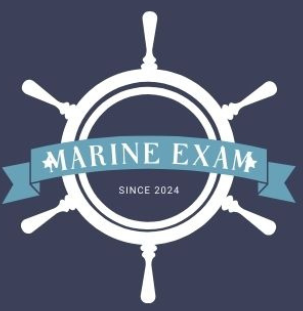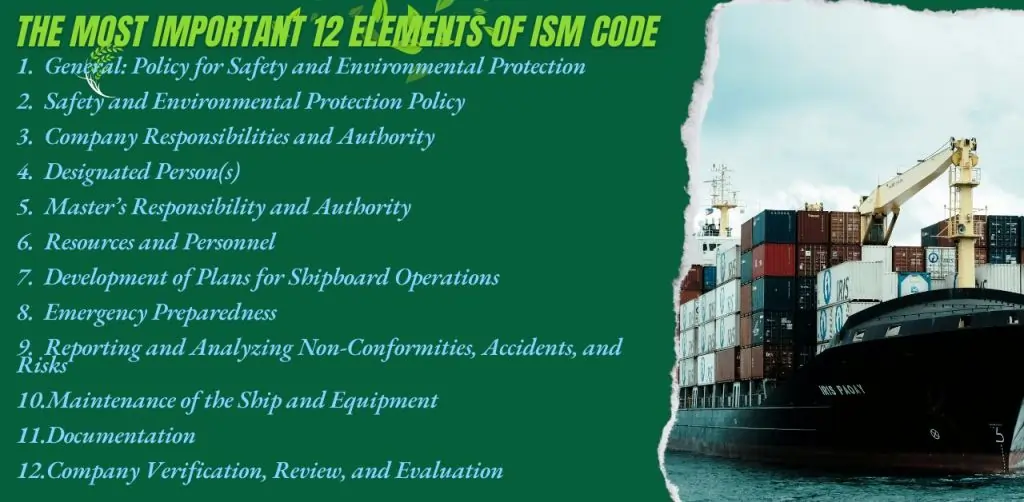The International Safety Management (ISM) Code stands as a cornerstone of global maritime safety and environmental protection. Established by the International Maritime Organization (IMO), it provides a structured framework to ensure the safe operation of ships, the prevention of accidents, and the reduction of environmental risks.
In 2025, the ISM Code remains more relevant than ever, addressing evolving challenges such as stricter regulations, technological advancements, and the urgent need for sustainable maritime practices. Its principles guide shipowners, operators, and crew in upholding safety standards and fostering accountability.
This blog explores the most important 12 elements of the ISM Code and their relevance in ensuring maritime safety, environmental protection, and compliance in 2025
What is the ISM Code?
Definition of the ISM Code
The International Safety Management (ISM) Code is a set of international standards established to ensure the safe management and operation of ships and the prevention of marine pollution. It provides a structured framework for shipping companies to implement safety and environmental protection policies effectively. The ISM Code is mandatory under the International Convention for the Safety of Life at Sea (SOLAS), requiring companies and vessels to adhere to its guidelines for certification and compliance.
Historical Context of the ISM Code
The ISM Code was introduced by the International Maritime Organization (IMO) in response to a series of catastrophic maritime accidents in the 1980s, which highlighted the need for a unified approach to safety management. Adopted in 1994, the ISM Code became mandatory on July 1, 1998, for passenger ships and tankers, and later expanded to other cargo ships. Its establishment marked a shift from reactive responses to proactive safety management, emphasizing accountability, structured procedures, and continuous improvement.
Importance of the ISM Code in Global Maritime Safety and Pollution Prevention
The ISM Code plays a crucial role in enhancing maritime safety and minimizing environmental risks. It ensures that:
- Ships are operated by qualified and trained personnel following clear safety protocols.
- Emergency preparedness and incident response are well-documented and practiced.
- Pollution prevention measures are integrated into operational processes, reducing harmful impacts on the marine environment.
Detailed Overview of the 12 Elements of the ISM Code
The ISM Code outlines 12 critical elements designed to ensure safe ship operations and protect the marine environment. These elements provide a structured framework for shipping companies to promote accountability, safety, and compliance. Below is an overview of each element, along with practical insights into their relevance in 2025.
1. General: Policy for Safety and Environmental Protection
- Implementing a company-wide dedication to safety and protecting the environment.
- Defining clear objectives for preventing accidents and pollution.
- Example: Companies integrating sustainability goals into their safety policies to meet stricter 2025 regulations.
2. Safety and Environmental Protection Policy
- Top management’s role in formulating, approving, and communicating safety policies.
- Ensuring policies comply with legal standards while addressing operational needs.
- Example: Leadership emphasizing digital monitoring tools for safety in operations.
3. Company Responsibilities and Authority
- Defining roles and responsibilities within the organization.
- Ensuring resources and support for policy implementation.
- Example: 2025 trends include automated compliance tracking systems for efficient oversight.
4. Designated Person(s)
- Assigning a designated person (or persons) to ensure communication between ship and shore.
- Accountability for monitoring the safety management system.
- Example: Use of real-time tracking and communication platforms for instant updates on ship operations.
5. Master’s Responsibility and Authority
- Granting the master overall authority for the safe operation of the ship.
- Empowering the master to make decisions during emergencies.
- Example: Enhanced training programs in 2025 to equip masters with skills in handling advanced navigational systems.
6. Resources and Personnel
- Ensuring the crew is adequately trained, certified, and rested.
- Maintaining a balance between operational demands and crew welfare.
- Example: Adoption of virtual reality (VR) tools for immersive crew training in safety protocols.
7. Development of Plans for Shipboard Operations
- Creating clear procedures for routine and critical operations.
- Ensuring plans are understood and practiced by all crew members.
- Example: Digital workflow tools are increasingly used to standardize operations across fleets.
8. Emergency Preparedness
- Preparing and practicing responses to potential emergencies.
- Regularly reviewing and updating emergency response plans.
- Example: Integration of AI-driven simulations for enhanced emergency drills in 2025.
9. Reporting and Analyzing Non-Conformities, Accidents, and Risks
- Recording and investigating incidents to identify root causes.
- Implementing corrective actions to prevent recurrence.
- Example: Data analytics platforms used in 2025 to predict and prevent non-conformities.
10. Maintenance of the Ship and Equipment
- Ensuring vessels and their equipment are regularly inspected, maintained, and repaired.
- Adhering to planned maintenance schedules.
- Example: Use of predictive maintenance systems to reduce downtime and extend equipment life.
11. Documentation
- Maintaining records of all operations, audits, and safety practices.
- Ensuring documentation is clear, accessible, and accurate.
- Example: Transition to blockchain technology for tamper-proof and verifiable records.
12. Company Verification, Review, and Evaluation
- Conducting internal audits to evaluate safety management systems.
- Ensuring continuous improvement through feedback and reviews.
- Example: In 2025, many companies use machine learning to analyze audit data for actionable insights.
Who Does the ISM Code Apply To?
The International Safety Management (ISM) Code is a mandatory framework that applies to specific categories of vessels and their operating companies. Its primary goal is to enhance maritime safety and environmental protection by establishing clear responsibilities and accountability.
Categories of Vessels and Shipping Companies Required to Comply
The ISM Code applies to the following types of vessels and their operators:
- Commercial Vessels Over 500 Gross Tonnage (GT):
Cargo ships engaged in international voyages must adhere to the ISM Code to ensure safe and efficient operations. - Passenger Ships:
Passenger vessels, including ferries and cruise ships, must comply to prioritize the safety of passengers and crew. - Tankers:
Oil, chemical, and liquefied gas tankers are held to stringent ISM standards due to the high risk associated with their operations.
Roles of Owners, Operators, and Managers in Compliance
- Shipowners:
Owners hold the primary responsibility for ensuring their vessels adhere to the ISM Code. - Ship Operators:
Operators manage the day-to-day functioning of vessels and ensure that all safety and environmental policies are implemented effectively onboard. - Ship Managers:
Managers oversee administrative and operational procedures, such as crew training, equipment maintenance, and emergency preparedness. They ensure adherence to the ISM Code’s requirements.
By defining these roles, the ISM Code creates a culture of shared responsibility that enhances safety and operational efficiency.
Significance of the Document of Compliance (DOC) and Safety Management Certificate (SMC)
- Document of Compliance (DOC):
Issued to the company after verifying the proper implementation of a Safety Management System (SMS), the DOC is a critical certification for demonstrating compliance with the ISM Code. - Safety Management Certificate (SMC):
This certificate is issued to individual ships following an onboard audit, confirming that the vessel operates in compliance with the approved SMS.
FAQ on ISM Code
Q. What is the ISM Code?
A. The ISM Code is an international framework that sets safety and environmental standards for ship operations.
Q. Who must comply with the ISM Code?
A. The ISM Code applies to commercial vessels over 500 GT, passenger ships, and tankers engaged in international voyages.
Q. What are the key objectives of the ISM Code?
A. The ISM Code aims to ensure the safety of ships, crew, and cargo while preventing environmental damage.
Q. What are the essential certificates required under the ISM Code?
A. The Document of Compliance (DOC) and Safety Management Certificate (SMC) are required for ISM Code compliance
Conclusion
The International Safety Management (ISM) Code continues to be a cornerstone of maritime safety and environmental protection. Its rigorous standards not only ensure the safety of ships, crew, and cargo but also play a critical role in preserving the marine environment. As the maritime industry faces evolving challenges, the importance of adhering to the ISM Code has never been more evident.
For stakeholders across the maritime sector—shipowners, operators, managers, and crew—prioritizing ISM Code compliance is essential. By embracing its guidelines, you contribute to safer and more sustainable operations, ultimately protecting lives and the environment.
As we move into 2025, it’s crucial to adopt innovative approaches, such as digital tools, predictive maintenance, and real-time data monitoring, to enhance the implementation of the ISM Code. By staying ahead of industry advancements and continuously improving safety systems, we can ensure a safer and more sustainable future for global shipping.

